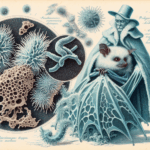The Fungal Double Agents
In a plot twist worthy of a sci-fi thriller, researchers have uncovered not one, but two cunning fungal species orchestrating the demise of our nocturnal allies. These cryptic culprits have been masquerading under a singular identity, causing the dreaded white-nose disease in bats. This revelation is not just a footnote in the annals of mycology but a clarion call to rethink how we surveil and manage these microscopic marauders.
Genetic Sleuthing: The New Frontier
Armed with the genetic equivalent of a magnifying glass, scientists have delved into the DNA of these fungal fiends. Their findings underscore a crucial point: genetic variability isn’t just a footnote in textbooks, but a pivotal factor in disease management. By integrating genetic studies into our surveillance strategies, we can outsmart these fungi before they launch their next covert operation.
Key Facts Worth Knowing
- •White-nose disease has decimated bat populations across North America.
- •The disease has been linked to two distinct fungal species, not just one.
- •Bats play a crucial role in controlling insect populations, impacting agriculture.
- •Genetic variability in pathogens is key to understanding disease spread.
- •Effective disease management strategies can help protect endangered bat species.





